 Back in 1937, author J.R.R. Tolkien crafted a little fantasy story you may have heard of called The Hobbit. I probably don’t need to explain to you what this book (or its wildly successful follow-up, The Lord of the Rings) is about. Since that time, there have been a number of games, movies and toys to take advantage of this fantasy license. One of my favorite Middle-Earth games was produced in 2004 (and again in 2012) called The War of the Ring. This epic game went on to win its fair share of awards and absolutely does the Lord of the Rings license justice.
Back in 1937, author J.R.R. Tolkien crafted a little fantasy story you may have heard of called The Hobbit. I probably don’t need to explain to you what this book (or its wildly successful follow-up, The Lord of the Rings) is about. Since that time, there have been a number of games, movies and toys to take advantage of this fantasy license. One of my favorite Middle-Earth games was produced in 2004 (and again in 2012) called The War of the Ring. This epic game went on to win its fair share of awards and absolutely does the Lord of the Rings license justice.
Today, game designers Roberto Di Meglio, Marco Maggi and Francesco Nepitello have jumped back in the saddle with their newest offering in Middle-Earth, The Battle of Five Armies. This time they are leaving the Lord of the Rings trilogy and instead, head back into the exciting conclusion of The Hobbit. Did this trio of designers strike gold again with their newest offering or should fans just stick with The War of the Ring? Let’s dive in and find out!
The Battle of Five Armies is a fantasy war game for 2 players published by Ares Games. The game takes about 90-120 minutes to play.
Game Overview:
While the title might make it sound like a five player game, The Battle of Five Armies is strictly a two-player affair. One player controls the armies of the Free People (Elves, Humans and Dwarves) and the other side controls the Shadow Armies (Orcs and Wargs). While each player uses similar rules and mechanics during the game, each player will have their own goals and ways they approach the game. The Shadow Player needs to control 10 victory points worth of settlements, while the Free Player has to hold out long enough for the fate track to end (or shorter if the Shadow Player doesn’t conquer settlements quick enough).
To accomplish these goals, players will be using the familiar action dice system introduced in The War of the Ring. Each turn, players will be mustering troops, moving around leaders, fighting battles and playing story cards. Be prepared to put for a heroic effort, for leading your troops to victory is no simple task.
Game Components:
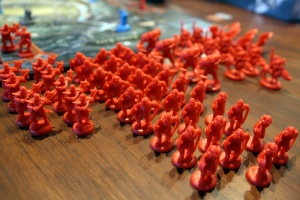
For the most part, Ares Games did a stellar job of putting together the components in The Battle of Five Armies. First off, each players gets a pile of miniatures to use to represent their various forces. From the different humanoid factions to the monstrous races, all are well sculpted and fun to play with. The character minis themselves are especially just begging to be painted.
Speaking of minis, I should note that my copy was missing two figures. There have also been more than a few reports on BGG of other people missing miniatures. Regardless, Ares customer service quickly shipped me out replacement figures once I contacted them about the issue. So while its never a good thing to be missing components, thankfully Ares is standing by their product and getting the missing troops was an easy fix.
Moving on, the game comes with a plethora of tokens, custom dice, story and actions cards, and even extremely handy player aids. With regards the dice, I enjoyed the custom action dice, but I do wish that Ares included about twice as many of the white/black battle dice. I prefer to roll at the same time as my opponent and rarely could we do that with the included dice. I will probably just end up tossing a few extra white/black dice in the box since they are fairly cheap.
Finally, the rule book that comes with the game does a great job of walking you through how to play. The Battle of Five Armies, while not the most complex of war games, still clocks in with a rulebook of 30+ pages. Fortunately, there are numerous game play examples, call-outs and even a handy index. Players should have no issues learning the game from the rulebook.
How to Play:
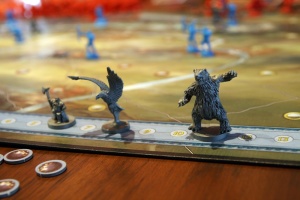
Speaking of learning the game, I’m not going to teach it to you the whole game here as that would be more words than you want to read. Instead, I’ll give you a general overview on how the game is played to give you a feel for it. If you want the full rules, here is a link to a PDF version of the rulebook Ares has posted on their website.
Once the game board is set up (the game has a static setup) and players have chosen their side, you are ready to begin. The game is played over a series of rounds, each of which is divided into 6 Phases.
Phase 1: Recovery
Players collect their action dice and draw two cards. One from their story deck and one from the shared event deck.
Phase 2: General’s Activation
The Free People’s player decides how many of their four generals they will be activating during their turn. They can choose as many as 3 of them or as few as none. Each general has a special power that their activation allows the free player to use. For each general they activate, they also get a leadership token to place with an army. However, there are consequences for activating generals…
Phase 3: Fate
At the bottom of the game board there is a 15 spot fate track. This is essentially the game’s timer. If the fate marker ever gets to spot 15, the Free People automatically win. Along the track, there are also 4 characters that will enter play for the Free People once the marker reaches their spot (Bilbo, Thorin, The Lord of the Eagles and Beorn). These are all very powerful characters that the good guys will eagerly anticipate getting their hands on.
During this phase, the shadow player draws a fate tile from a bag/container. The fate tracker will move either 1,2 or 3 spaces, depending on the tile drawn. For each general the Free People activated in the previous phase, the Shadow Player can draw a new tile to replace the previously drawn one. There is a push your luck aspect here, as the Shadow Player really wants to draw a “1” tile. If the Free Player activated enough generals in step 2, it can make it easier for him to find one.
Phase 4: Shadow Leadership
The Shadow Player places a number of Leadership Tokens or Great Bats equal to the amount of dice they have. Leadership tokens let players move armies faster or re-roll dice during combat.
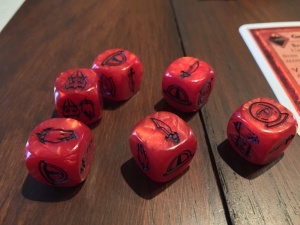
Phase 5: Action Round
This is where the meat of the game happens. Players roll all of their action dice and then take turns using them. The dice can have 6 possible results:
Army: Move or attack with your armies
Character: Move a character or attack with a character led army.
Event: Play or draw cards
Muster: Place troops on the battle field or heal troops
Will of the West (Free People Only): Wild card for any of the above results.
Lidless Eye (Shadow Player Only): Recruit Goblins or use armies with Goblins.
Combo: All dice have a combo Muster/Army symbol that the player can use for either result.
Those are fairly brief explanations of what the dice do. In addition to those results, cards can be played on any die result where the symbol matches the symbol on the card. Overall there are a lot of ways to use your dice on a turn.
Combat is a tad fiddley, but overall works well. To go over it in brief, both players will play a card at the start of each round of combat. This will give them an ability for that round. Then players calculate their army’s strength and roll that many dice (max of 5). Any 5 or a 6 is a hit. Players can re-roll dice based on their leadership score. Damage tokens are applied to the army for each hit. When the number of tokens exceeds the quantity of units in the army, the player must remove 1 unit for every two tokens of damage until you are back under the maximum amount.
Phase 6: End of Turn
This is just a cleanup phase.
Once the round ends, a new rounds starts with Phase 1. The game continues in this fashion until one player completes their objective.
Free People: Fate Marker reaches step 15, Bolg is killed or Beorn enters play and the Shadow Player has less than 6 Victory Points.
Shadow Player: Control 10 Victory Points worth of Settlements
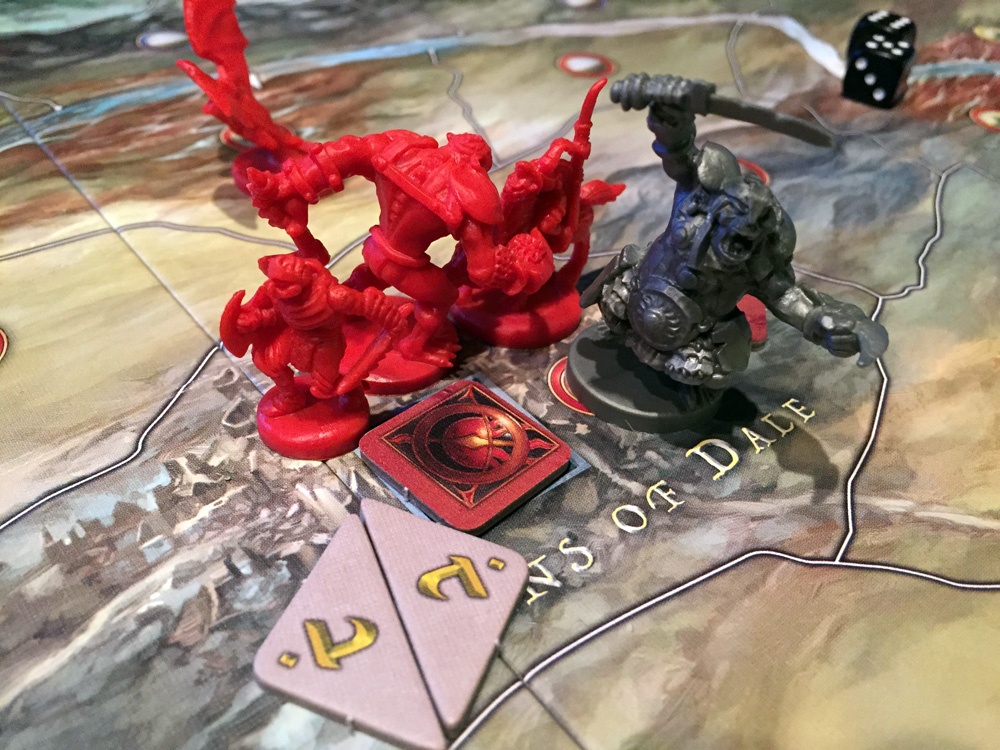
Game Experience:
Still with me? Good. While not the most complex war game out there by a long shot, The Battle of Five Armies is still quite the involved game. But with that comes the epic feeling that you’d expect with a large clash of armies at the door step of the Lonely Mountain. The Battle of Five Armies was quite the event in The Hobbit and the trio of game designers did an absolutely amazing job of capturing the feel of the battle. But we’ll get to the theme in a minute.
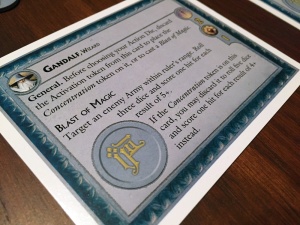
The Battle of Five Armies is not a short game by any means, but fortunately, the game doesn’t feel long when you are playing it. The game has a great flow and turns seem to go by quickly, so down time is minimal. Yes, there are 6 different phases, but each one except for the action phase will zip by quickly. To be honest, time tends to fly by when we are playing The Battle of Five Armies. I love when a game can grip me like that.
Speaking of time, I think the box is a tad optimistic on the 60+ minute play time (unless they are being very liberal with the “+”). Expect your games to take 90-120 easily unless one side plays somewhat poorly. Even if it clocked in at 90 minutes, that’s still about half the play time of The War of the Ring.
My favorite aspect of The Battle of Five Armies is probably the asymmetrical game play. I absolutely love when players have to play the same game differently (See Netrunner and Trieste for more asymmetrical games I love). While the rules are mostly the same for both players, your approach to the game is going to be very different. The Shadow Player must be on the offensive and be a risk taker. Because of the fate track, you usually don’t have time to slowly build up your armies to a boiling point. Strike hard and strike quick. In one game, the shadow player took their first settlement on turn one. That’s the kind of power you need to put on display as the forces of Evil. To contrast that, one of our games ended quickly because Beorn entered play and the Shadow Army had only captured 1 settlement. Oops.
On the other side of the battle, the Free People will be spending a lot of their time putting out fires. The Shadow Armies have superior numbers and will constantly be assaulting your positions. Be prepared to feel like you are on constantly the ropes. There are just so many important areas to protect that you will never feel like you have enough men. This is especially true when the goblins break through the mountains and enter on your flanks. All you can do is will that fate track to move quicker to get your various heroes into play.
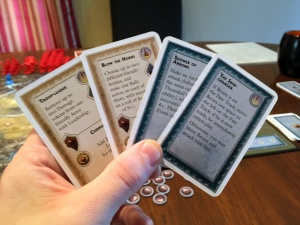
And rooted in this game play is where the theme really shines home. The Free People are under assault and are trying to bide their time. There are heroes moving around the area, rallying troops and using their considerable influence to swing the tide of the battle. And finally, each player’s unique deck of story cards bring it all home. Throughout its entire play, I feel like I’m in an epic battle on Middle-Earth. I can tell the designers really paid attention to the source material in The Hobbit. Thorin will sit under his mountain until you are sure you need his help, the goblins will crash in from the rear and when Beorn arrives, the Shadow Player knows they’re in trouble. If you’ve read The Hobbit, you’ll find a lot of similarities here to the book. For those of you that like a strong theme in a game, you’ve found one here.
Under this fantastic theme is a set of game mechanics that, for the most part, work really well. Armies move around the board at a decent pace (even faster if they have a leadership) which keeps the game moving along. The fate track will keep the Shadow Player sweating, while the two armies of goblins threatening to burst in from the rear will give the Free People’s player something to worry about. There are a lot of moving parts in The Battle of Five Armies and at the heart of it is the action dice system.
Yes, Action Dice. Luck is going to play a factor in The Battle of Five Armies. From what cards you draw, to the outcome of battles, to what you can do on a turn. If you really want to move your armies and you only roll muster results, you’re going to be frustrated. Fortunately, the game designers built a lot of redundancies in the dice mechanics. If you have an army with leadership, you have at least 3-4 different die results that can activate them (maybe more with the right event cards). This bit of forethought has luck still being a factor on what you can do on your turn, but rarely should you be handicapped by it.
In fact, the place where you will be most effected by luck will probably be the combat. While you can set your self up for success with the right amount of troops or playing the right card, at the end of the day it will still come down to a die roll. One of my Shadow Armies was able to break right into a fortification because I rolled 4 “6’s” on my first attack roll. While that’s rare to happen, it can absolutely swing the tide of a battle.
Finally, I have to say that I absolutely love the hero characters in the game. Each one feels unique and contributes to the game in different ways. As the Shadow player, I’m completely jealous of the Free Peoples pile of characters they get to use when I only have one. Although Bolg is an absolutely monster in combat, you have to balance bringing him with an army vs risking his death (and losing the game). The Free People have that same risk, but they have more characters to part with (Bard always seems to die in our games).
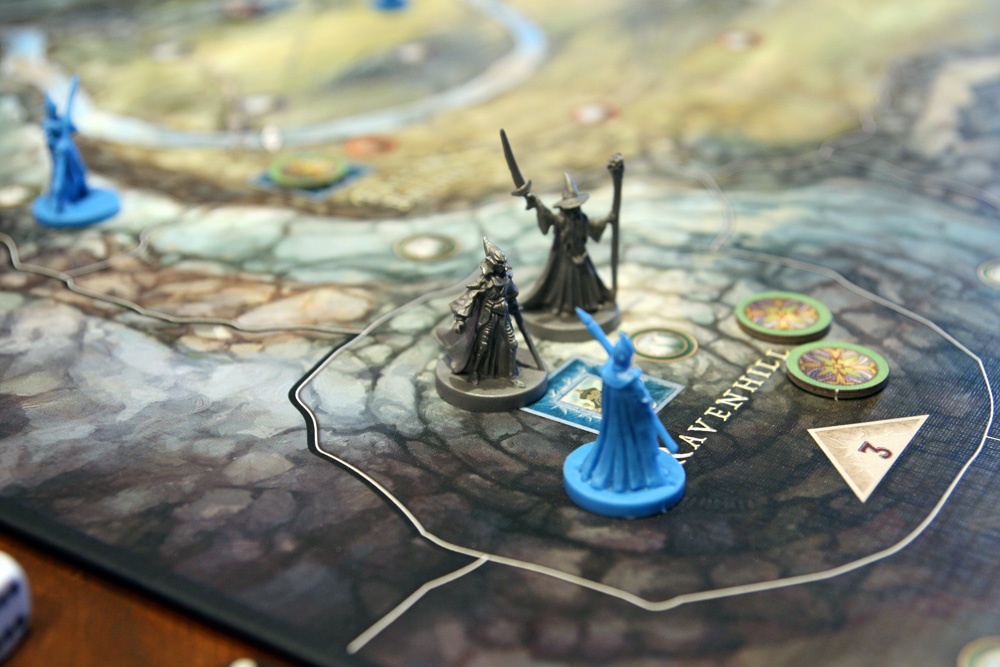
Final Thoughts:
I really enjoyed The Battle of Five Armies… a lot. I was expecting a well crafted sequel to The War of the Ring rooted in a deep theme. I’m very happy that I can say that the designers absolutely delivered on that. The pacing of the game works really well, combat is fierce and frequent, and Middle-Earth shines throughout the game. If I had to nitpick, I’d say the combat can feel a little clunky at times with the damage tokens, but really, that’s a minor criticism of an absolutely fantastic game. Honestly, I can’t wait to get this one to the gaming table again.
While not as grand of a scale as The War of the Ring, The Battle of Five Armies captures your attention from the first die roll and I guarantee it will keep you glued to the board for the long haul. The game play, production values and the minis help to make The Battle of Five Armies worth every penny of its hefty price tag. If you are a fan of the Lord of the Rings series, or even just fantasy war games in general, then treat yourself to a copy of The Battle of Five Armies. It’s an absolutely stellar and bloody romp through Middle-Earth.
If you are interested in getting a copy for yourself, you can get it for about $65.
Final Score: 5 Stars – The Battle of Five Armies is an incredibly well designed game that I am really enjoying. This one has a permanent place in my game library.
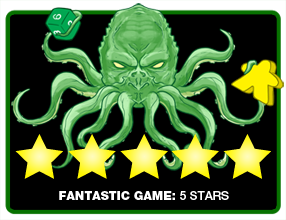 Hits:
Hits:
• Deep and engaging game play
• A very thematic journey in Middle-Earth
• Minimal downtime, turns go by quickly
• High quality components with great looking minis
Misses:
• Damage tokens can feel a little clunky at times.







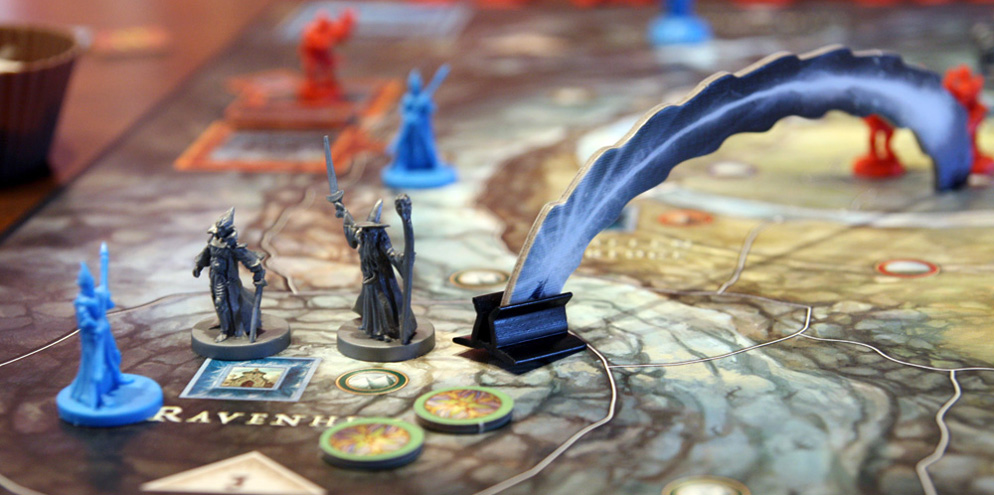















I’d rather just play War of the Ring
I’ve been considering buying this for a little bit. Thanks for helping speed along my decision!